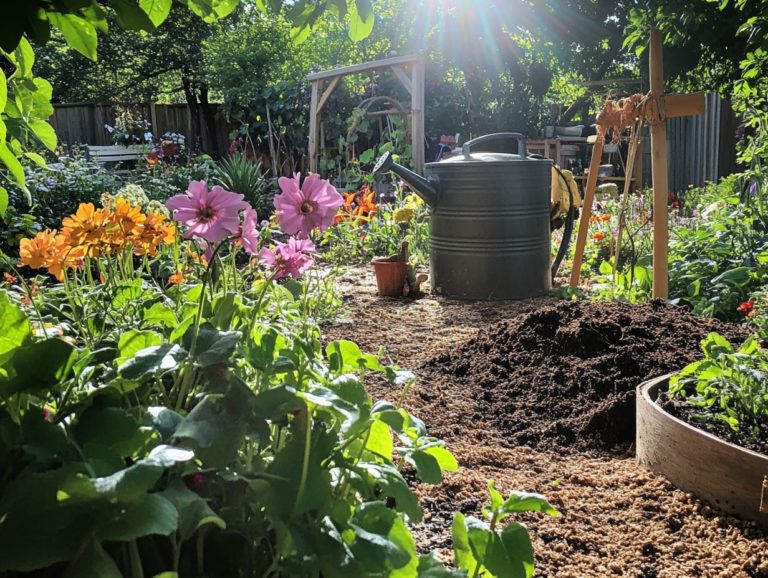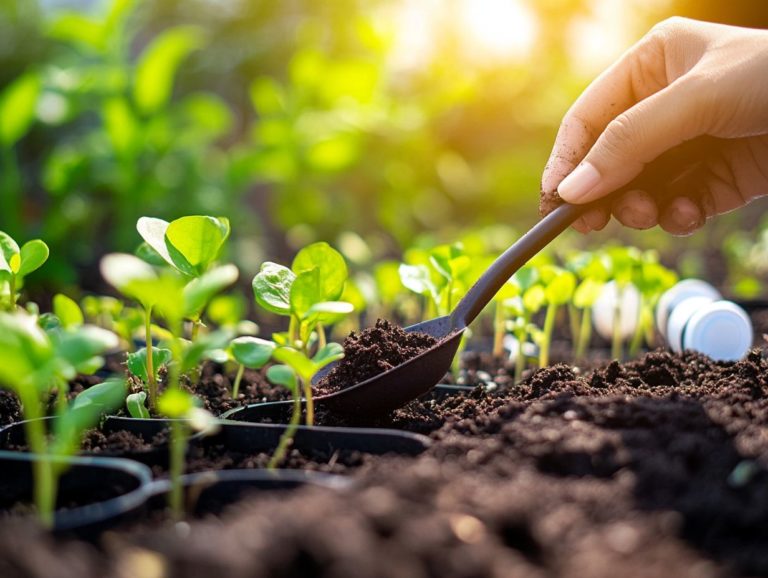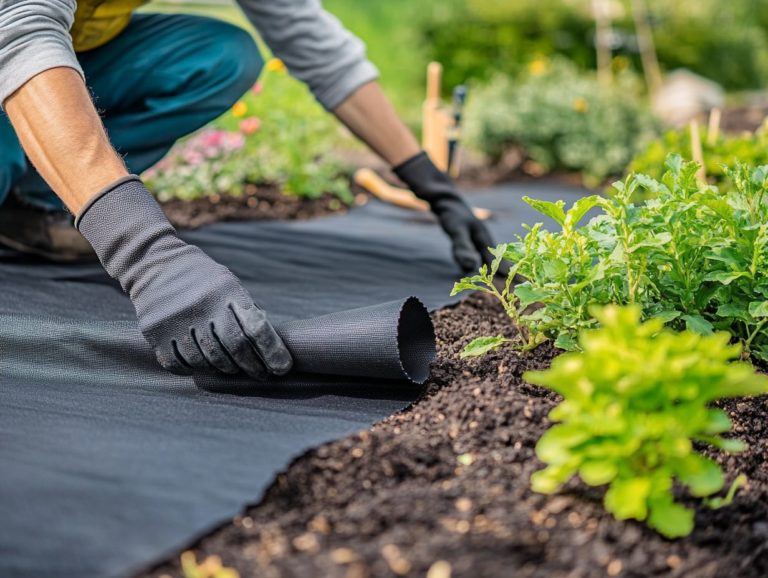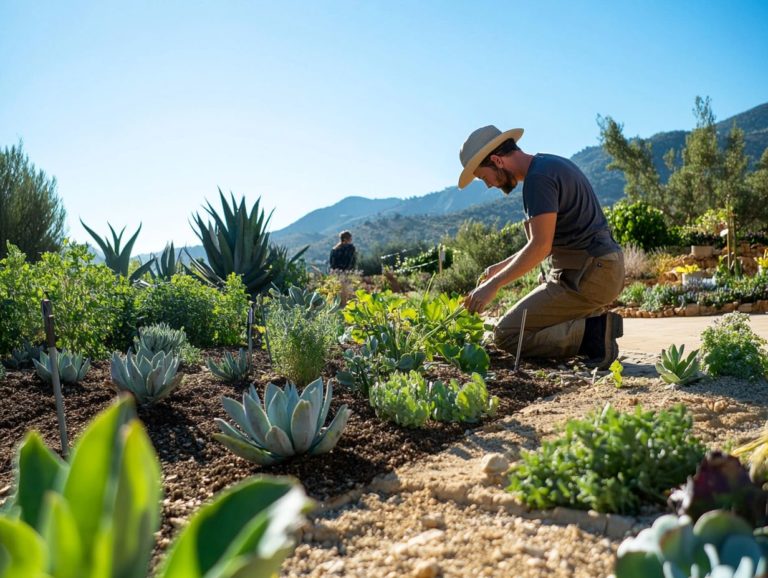Establishing a Drought-Tolerant Garden
In today s world, where water scarcity is becoming an ever-pressing issue, crafting a drought-tolerant garden is more than just a trend it s a necessity.
This article delves into the myriad benefits that these gardens provide, both for the environment and for you as a homeowner. By carefully selecting the right plants and embracing water-wise design strategies, you can create a sustainable oasis of beauty.
From grasping the unique characteristics of drought-tolerant plants to mastering maintenance techniques and tackling potential challenges, you ll uncover essential tips for nurturing a vibrant garden that flourishes even in the driest of conditions.
Contents
- Key Takeaways:
- The Importance of Drought-Tolerant Gardens
- Choosing Drought-Tolerant Plants
- Creating a Water-Wise Landscape Design
- Implementing Drought-Tolerant Gardening Practices
- Dealing with Drought-Related Challenges
- Additional Considerations for a Successful Drought-Tolerant Garden
- Frequently Asked Questions
- What does it mean to establish a drought-tolerant garden?
- Why is it important to have a drought-tolerant garden?
- What are the benefits of having a drought-tolerant garden?
- How do I choose the right plants for a drought-tolerant garden?
- What are some water-saving techniques for a drought-tolerant garden?
- Can I still have a beautiful garden with drought-tolerant plants?
Key Takeaways:
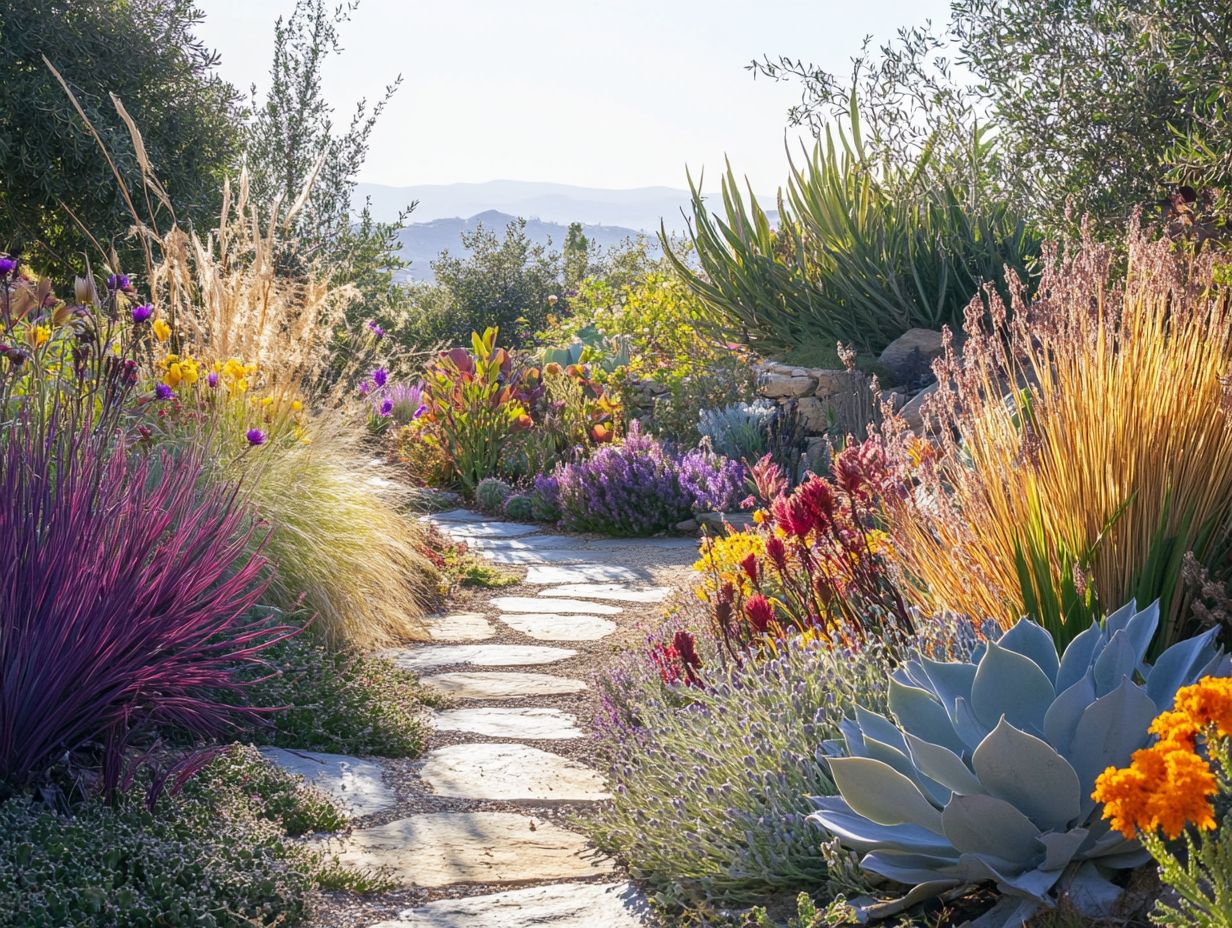
- Drought-tolerant gardens benefit both the environment and homeowners, reducing water usage and maintenance while providing a beautiful landscape.
- When choosing plants for a drought-tolerant garden, consider their characteristics such as drought resistance, low-water needs, and ability to thrive in your climate.
- To create a successful drought-tolerant garden, utilize strategies such as proper watering techniques, mulching, and selecting native plants to conserve water and support long-term growth.
The Importance of Drought-Tolerant Gardens
Drought-tolerant gardens are essential in contemporary landscaping, particularly in regions like California and Texas that often face drought conditions. Learning how to create a wildlife-friendly drought garden can enhance your outdoor space while supporting local ecosystems.
As climate change worsens water scarcity, embracing drought-resistant plants allows you to foster a variety of plants and animals while significantly reducing your water requirements.
By choosing native plants that naturally thrive in your local climate, you can craft a lush, vibrant landscape that flourishes with minimal irrigation. This approach honors the intricacies of Mother Nature s design while helping local water resources.
Benefits for the Environment and Homeowners
Drought-tolerant gardens offer a wealth of advantages for both the environment and you as a homeowner. These include improved soil moisture retention and notably lower water bills.
These gardens also help reduce maintenance costs while promoting enhanced plant health. By incorporating organic mulch, you can effectively minimize evaporation, ensuring that your plants retain moisture for extended periods. This not only fosters better growth but also cuts down on the need for constant watering.
To maintain optimal moisture levels in your soil, establish a straightforward routine for monitoring. Simply check the soil’s dampness a few inches deep with your fingers. For your young plants, consider installing a drip irrigation system or soaker hoses these methods deliver water directly to the plant roots, saving water and ensuring they get just what they need.
Regularly replenishing your mulch will safeguard those delicate roots during the hotter months. This allows you to cultivate a thriving, eco-friendly landscape.
Choosing Drought-Tolerant Plants
Choosing the right plant varieties is crucial for cultivating a thriving drought-tolerant garden. Many homeowners find success by learning how to choose drought-resistant plants for your garden and opting for drought-resistant and native species like:
- Agave
- Lantana
- Euphorbia
Types of Plants and Their Characteristics
Different types of drought-tolerant plants showcase a variety of characteristics, making them ideal for a range of garden designs. For instance, Ceanothus and Perovskia stand out as popular choices due to their resilience and beauty.
Beyond their stunning appearance, these plants flourish in arid conditions, often requiring minimal irrigation once they’re established. Take Ceanothus, for example. Its growth patterns can create lush green backdrops that bring life to your garden. Meanwhile, Perovskia, commonly known as Russian sage, offers silvery foliage paired with striking purple flowers that captivate the eye.
Incorporating species like Miscanthus can elevate your garden’s sustainability even further. Renowned for their ornamental grass qualities, these plants stabilize soil and enhance aeration, which is crucial for maintaining soil health, especially during dry spells.
By thoughtfully selecting and combining these drought-tolerant plants, you can cultivate a vibrant, self-sustaining ecosystem that not only pleases the eye but also promotes environmental wellness.
Imagine a garden that thrives even in the toughest conditions! Start your journey by learning how to design a drought-tolerant landscape today and share your gardening experiences with us!
Creating a Water-Wise Landscape Design

Crafting a water-wise landscape design requires meticulous planning, focusing on elements that optimize soil retention, reduce runoff, and improve temperature regulation.
By thoughtfully integrating these features, you can create a sustainable environment that not only conserves water but also enhances the overall aesthetic and functionality of your outdoor space.
Strategies for Conserving Water
Adopting effective strategies for conserving water is crucial if you want to maintain a thriving garden. Techniques like deep watering and minimizing evaporation can be particularly beneficial in achieving this goal.
Consider implementing mulch. It helps retain soil moisture and reduces how often you need to water, which is vital for fostering healthier plant roots.
Grouping plants with similar water needs together is also a smart move, allowing for more efficient irrigation practices.
If you’re aiming to elevate your gardening expertise, incorporating drought-resistant varieties can significantly decrease your overall water consumption. Using rain barrels to collect runoff promotes sustainability and lessens your dependence on municipal sources.
Don t wait set up a watering schedule now, especially during the cooler parts of the day, to enhance your water management. This ensures your plants receive just the right amount of hydration to truly flourish.
Implementing Drought-Tolerant Gardening Practices
Adopting drought-tolerant gardening practices can transform your garden into a vibrant oasis, ensuring your plants flourish even in the face of limited water availability. To learn more about this approach, check out how to get started with drought-resistant gardening. Embracing effective planting tips and using natural mulch are key components in this endeavor, helping you create a resilient and vibrant garden.
Tips for Proper Watering and Maintenance
Proper watering and maintenance techniques, such as deep watering and regularly monitoring soil moisture, are vital for nurturing young plants in drought-tolerant gardens.
To cultivate effective watering habits, you must develop a keen understanding of when and how much to water. It s generally recommended to water deeply but less frequently, allowing the soil to dry out between sessions. This method encourages roots to stretch deeper, enhancing their resilience during those sweltering days.
Timing is also critical; early mornings or late afternoons are your best bets for minimizing evaporation and maximizing absorption.
Consider incorporating an irrigation system to maintain consistent moisture levels. This approach safeguards your plants from both drenching and drought while adapting to the fluctuating demands of seasonal climate changes. Striking this balance ensures long-term growth and vitality in any garden setting.
Dealing with Drought-Related Challenges
Navigating the challenges posed by drought demands a level of preparedness and an understanding of the common issues that can impact plant health and resilience in these harsh conditions.
By equipping yourself with the right knowledge, you can effectively safeguard your plants and ensure they thrive even in the most demanding environments.
Common Issues and Solutions

In drought conditions, you may encounter various challenges with your plants, such as stress and stunted growth, particularly among younger specimens. However, you ll find that native species often demonstrate a remarkable resilience in these situations.
This resilience is essential, as drought not only limits water availability but can also lead to nutrient deficiencies and heightened vulnerability to pests. To combat these issues, consider adjusting your irrigation system; it can truly make a significant difference.
Implementing drip irrigation, which delivers water directly to the roots, reduces waste and ensures that roots receive moisture exactly where it s needed most.
Using mulch is another effective strategy, as it helps retain soil moisture and regulate temperature. Regularly monitoring soil moisture levels will enable you to determine the optimal watering times, preventing the overwatering that can be just as detrimental.
By incorporating these strategies, you can cultivate a robust approach to maintaining plant health even in challenging conditions.
Additional Considerations for a Successful Drought-Tolerant Garden
To cultivate a thriving drought-tolerant garden, you must contemplate several essential factors. Key among these are the significance of biodiversity and the integration of organic matter into your soil.
These elements will not only enhance the resilience of your garden but also create a harmonious ecosystem that thrives even in challenging conditions.
Factors to Keep in Mind for Long-Term Success
Long-term success in your drought-tolerant garden hinges on regular maintenance practices and effective soil retention strategies. Additionally, knowing how to plan a drought-resistant garden layout and choosing native plants that flourish in arid environments is also crucial.
To cultivate a thriving landscape that can endure dry spells, it s essential to enrich your soil with organic matter. This will boost its capacity to retain moisture while enhancing nutrient availability.
Monitoring moisture levels is key when selecting plants well-adapted to your local climate. This not only fosters biodiversity but also significantly reduces the need for extensive watering.
Incorporating sustainable watering techniques, such as rainwater harvesting or drip irrigation, will minimize water usage. Techniques like landscape irrigation can also be effective.
By embracing these thoughtful strategies, you create a resilient ecosystem that conserves resources while continuing to thrive in challenging conditions.
Frequently Asked Questions
What does it mean to establish a drought-tolerant garden?
Establishing a drought-tolerant garden means creating a landscape designed to thrive in times of water scarcity. This includes choosing drought-resistant plants that are naturally adapted to dry conditions and implementing water-saving techniques.
Why is it important to have a drought-tolerant garden?
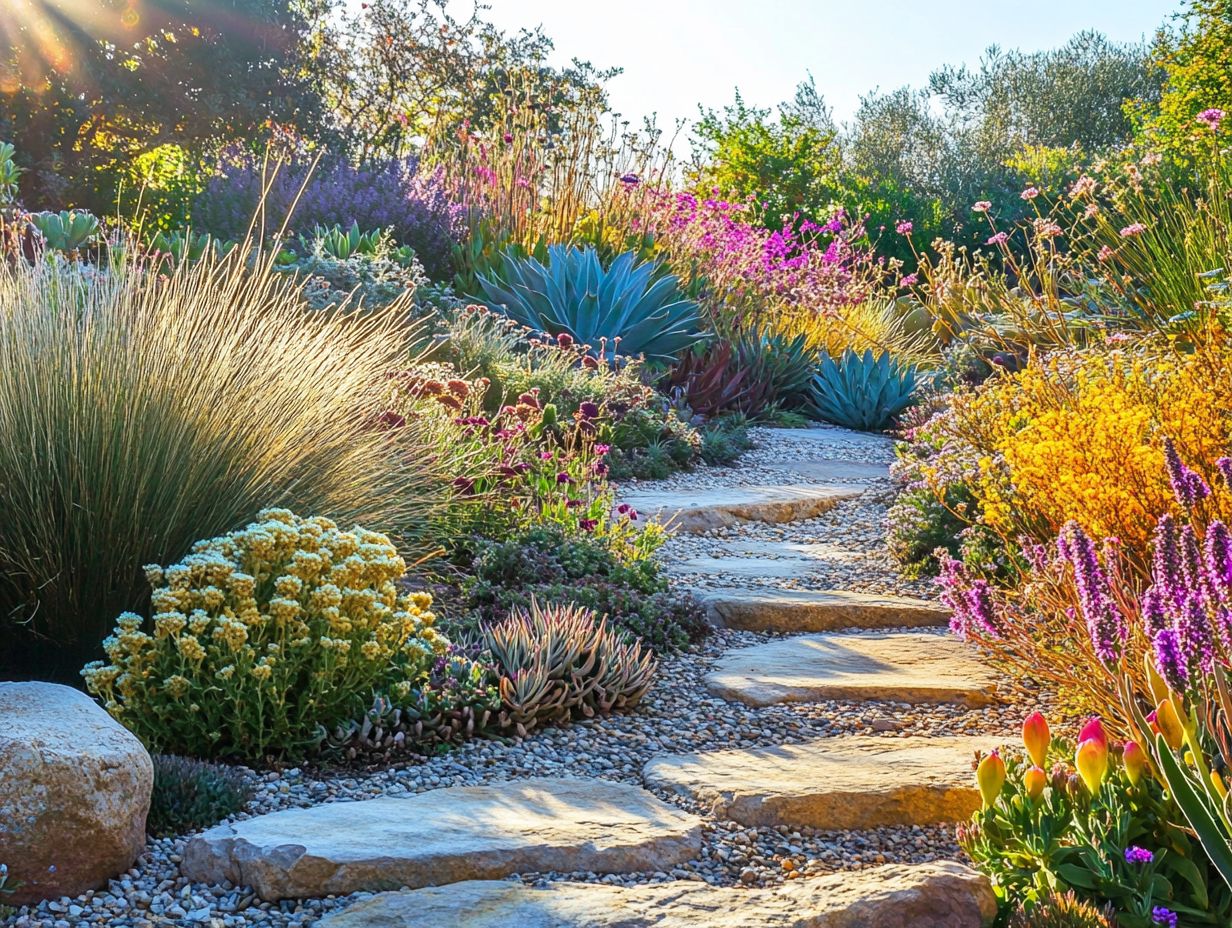
Drought-tolerant gardens are important because they conserve water and reduce maintenance costs. They also support the local ecosystem and help lessen the impact of droughts and other extreme weather conditions on the environment, especially in regions like California, Texas, and the Southwest.
What are the benefits of having a drought-tolerant garden?
Some benefits of having a drought-tolerant garden include lower water bills, reduced maintenance time and costs, and increased biodiversity. They also provide habitat for thirsty plants and wildlife, creating a vibrant and resilient landscape.
How do I choose the right plants for a drought-tolerant garden?
When selecting water-efficient plants for a drought-tolerant garden, look for species that are native to your region or well-adapted to dry conditions. Deep roots will help these plants require less water and maintenance, making them more likely to thrive in your garden.
What are some water-saving techniques for a drought-tolerant garden?
Some water-saving techniques include using mulch to retain moisture in the soil and grouping plants with similar plant needs together. Using drip irrigation or a soaker hose instead of sprinklers is also advisable to reduce water waste.
Can I still have a beautiful garden with drought-tolerant plants?
Absolutely! Many stunning and colorful flowering plants are well-suited for drought-tolerant gardens. By carefully selecting and arranging these plants, you can refer to a guide on how to plan a drought-resistant community garden to create a beautiful and sustainable landscape that thrives in dry conditions.
Ready to get started on your drought-tolerant garden? Take the first step today!


